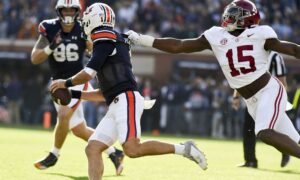Target Share Report: Week Two
Our sample size of player usage just doubled, can I get a nerd high five? Also, watching football was pretty fun, I suppose.
Week two brings us some interesting trends and more context for what will – or could be – the usage of players throughout the season. But it also brings some specific difficulties for calculating target share. So let’s clear the air, make sure we’re talking about the same thing, then take a look at who’s ballin’ the most in 2020, okay?
Cool.
Target share isn’t always the percentage of pass attempts
Target share is not objective. Now you may say: “What are you even talking about, Pahowdy? Numbers are facts and are entirely objective. Get out of here with that noise.”
And to that objection, fictional commentator, I say, no, no, numbers are not perfect. Rotoviz (where I’m taking all my data from), for example, screens out throw-aways. This means the total for team attempts is different than say, 4for4.com (who filter out other types of passing attempts if I don’t miss my guess.)
What’s more, what do we do with Jamison Crowder? Through two games, he’s played once. So his 39% target share is… not real, is it? They have thrown more, he wasn’t targeted, but his target share stays the same? Really?
“Per game….mumble mumble”
Nice idea, but what about Miles Sanders? He didn’t play the first game, but played the second game, and looks ready to play in week three. Do we want to half his current role? I don’t.
And that’s before you get to the “small sample” issue of having a two-game history. Here is a picture of the top target shares through two weeks of the NFL season, last year, next to the player’s target share by the end of 16 weeks.

Through two weeks of 2019, there were seven players with a target share over 30% (which is insane.) By the end of the season, there were three players with a target share over 30% (average is two, so it was still high to be fair).
“Why do you bore me with an explanation before getting to the goods, nerd?”
I don’t mean to, fictional commentator. But I want to be clear what we’re talking about. We can adjust, but not based on calculations, in my opinion. Instead, you should apply an actual understanding of what a team is doing, who they have faced, and who these players are. Numbers are useful – they are, in some sense, objective. But they are not ultimate, nor free from an interpretation even when it’s unintended.
How have I dealt with this? Well, Crowder has a 38% target share and I’m going to assume we’re all smart enough to recognize it’s not exactly true right now. They are unadjusted, in other words.
Lecture over, let’s get to some player usage, eh?
Target Share Leaders
Here are the top 12 players in target share through two weeks of the 2020 season.

Much like in 2019, there are way too many target shares up over 30% (eight) to be sustainable. But, also as with 2019, it’s still a strong indicator of those who will mostly finish as targets hare leaders for their teams, or at least with a fantasy-relevant role for the rest of the season.
Jamison Crowder, WR NYJ
As mentioned above, this is just unrealistic. The Jets are not – breaking news – a great team to expect a lot of fantasy points for. Doing projections this week is an honest struggle to get Sam Darnold as a starting quarterback in terms of raw projected points – mainly because it’s hard to find people who are going to catch passes. Again, as I explored in the off-season, the “all the free volume because there’s no one else there” is largely a fallacy.
This does not mean Crowder or (holds breath) Denzel Mims (when healthy) are going to be great. Their team will have fewer red zone trips, fewer plays, and overall less success, which means the players will also struggle. But as we know, good players in bad situations can score points. Crowder, at least, fits that description. Just don’t, please, expect a top-12 finish week to week.
N’Keal Harry, WR NE
It feels disingenuous to be excited about Harry on a team with Julian Edelman, who just had an amazing performance in week two. But… dynasty means we should be. As someone who was eating a lot of crow on Harry as a prospect, I love it.
The team is throwing significantly less than last year, and that’s important. But he’s currently the WR33 in PPG (PPR) and I think their passing game scripts in the future will edge Harry into breakout territory.
Diontae Johnson, WR PIT
Truthers, rejoice! He’s looking legitimate – he is also the second scoring wide receiver on his team. So as not to slip into confirmation bias, I want to point out that (while week two might have been a high watermark for his production) at his current usage, his scoring output should climb over JuJu Smith-Schuster.
Still have a hard time believing that, myself, but his usage suggests it right now.
Keenan Allen, WR LAC, Allen Robinson, WR JAC, and DJ Moore, WR CAR
On the list of unsurprising things (for those reading this article last week), we saw several team’s top wide receivers returned to the front of their depth chart in target share. I’d be careful “blaming” Mike Williams’s role reduction on the quarterback switch, as well. Anthony Miller, Mike Williams and Robby Anderson all look to have relevant roles for fantasy this season, but their role reduction just seemed fated based on these particular dominant player’s histories.
Tight end Top ten
Darren Waller in the top 12 overall makes me think we should take a look at tight end targets a little closer.

Logan Thomas, TE WAS and Evan Engram, TE NYG
Both look like they could have a game coming their way. They are getting more usage than their production output suggests.
Hunter Henry, TE LAC
Honestly had no idea Henry was the second-highest target share tight end. Let’s hope he can be one of the only players to make it out a season without an injury for the Chargers.
Mike Gesicki, TE MIA
Gesicki’s top-12 finish last year all but told us he’d have a decent, at least, year in 2020, but his week two showed a lot more upside than I’d imagined. Nice to see.
Jonnu Smith, TE TEN
Finally! Some truthers trains are harder to ride than others, and tight end is always the worst. It’s just great to see Smith come into form and at a time when the team needs help sustaining itself with AJ Brown injured. Anything to prop up Corey Davis season.
Unexpected target Share
Okay, time to close out the week looking at players getting more targets than you’d expected based on their team position rank.

Josh Malone, WR NYJ
Having an above-average target share for the fifth wide receiver ion a depth chart is not, exactly, impressive. However, Malone is someone I had very deep sleeper interest once upon a time when he was added to the Bengals depth chart a few years ago. He had an age-20 breakout age at a 30% threshold (good enough), and fourth-round draft capital.
With the utter graveyard of a receiver corps on the team right now, someone who once showed some promise in college is probably as good as we get on the Jets.
It is hard to add him to most teams right now, but if your league rolls that deep, I’d consider it.
Mike Davis, RB CAR
I never considered Davis a receiving back, but usage is usage. He’s done “okay” in the role and there’s not much to threaten it on the depth chart right now. His usage is one to consider right now.
KJ Hamler, WR DEN
Hamler was a very productive college player with decent draft capital and good athleticism. After hearing a lot about how there was “no path to production” for him on the Broncos all off-season, I’ll take what I can get. This is positive and I’m taking it. I’d put him above Malone on that “deep” add list, but, still hard to believe he will be fantasy-relevant this year.
He also had an age-20 breakout age with a 30% threshold, and he also has (much better) second-round draft capital, than Malone. (He also hasn’t switched teams, like Malone has, which is often a negative signal for a breakout early in a career.)
AJ Green, WR CIN, Allen Robinson, WR CHI, and DJ Moore, WR CAR
As we’ve already seen in week two, we should expect these leading wide receivers to take back that depth chart rank sooner rather than later.
Having said that, I’m listening to perhaps lesser-known, deeper depth chart wide receivers I had some interest in. It’s worth noting that Darnell Mooney is the leading PPR scoring wide receiver on the Bears right now.

Again, he should fall behind Robinson (some serious regression due) soon, and I think Miller is clearly the second. But, positive signs for a player with an age-19 breakout age (30% threshold) and fifth-round draft capital in his rookie season.
Zach Ertz, TE PHI
He has still not been traded away, is still good, and (obviously) has a much larger target share than any second-ranked tight end on a depth chart could hope to have. We have a living breathing two tight end offense in the NFL right now, excited for it.
Okay, that’s all I have for now. I have updated the data in my public google sheet if you want to explore more stats for 2020 or more target shares then I’ve been able to look at here.
Thanks again, and good luck in those week-three streets
- Peter Howard: Dynasty Fantasy Football Superflex Rankings Explained - March 6, 2024
- Dynasty Target and Regression Trends: Week 15 - December 23, 2023
- Dynasty Target and Regression Trends: Week 14 - December 16, 2023


































































